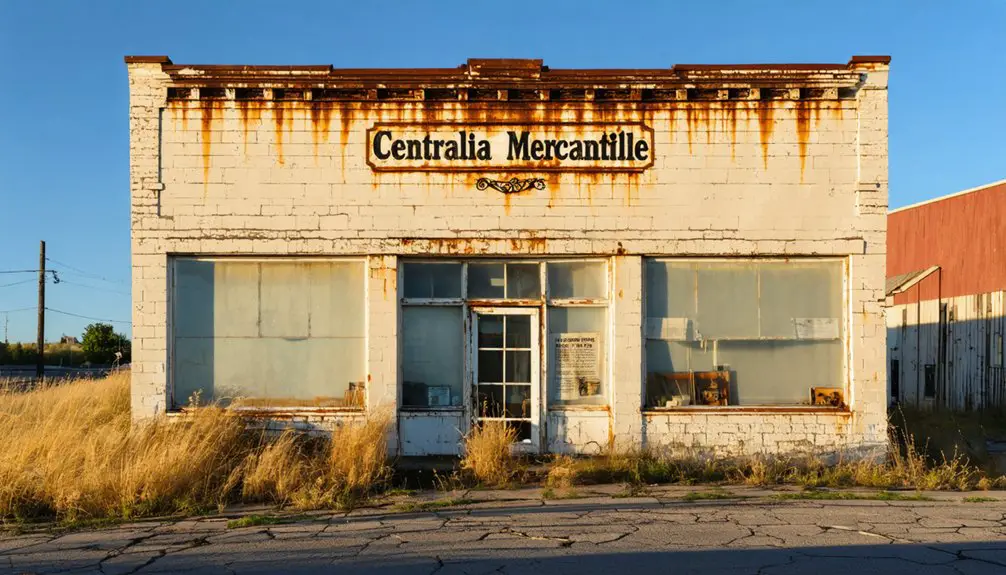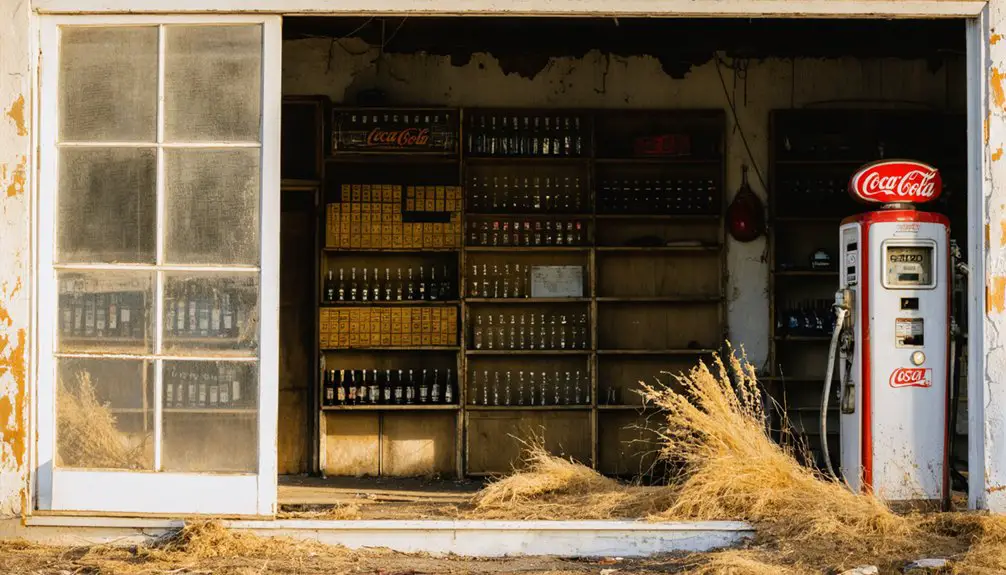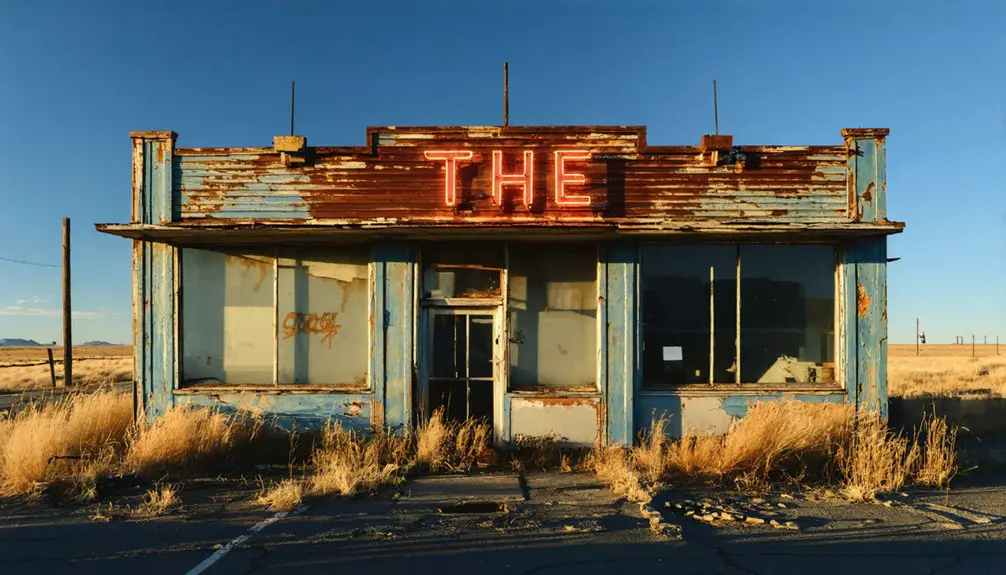You’ll find Centralia’s ghost town remnants in northeastern Oklahoma, where J.H. Hargrove established this prairie settlement in 1898. At its peak in 1915, the town boasted 750 residents and a bustling town square with wooden storefronts. Two devastating fires in 1907 and 1917, coupled with bank failures and the Great Depression, triggered its decline. By 1980, only 43 residents remained, leaving behind the cemetery, fire district office, and haunting stories of a once-thriving community.
Key Takeaways
- Centralia, Oklahoma, founded in 1898, declined from a peak population of 750 residents to just 43 by 1980, becoming a ghost town.
- Two devastating fires in 1907 and 1917 destroyed the business district, contributing significantly to the town’s eventual abandonment.
- The town’s isolation deepened when it missed railroad connections and the Ozark Trail bypassed it, cutting off vital transportation routes.
- Local bank closures in 1929 and the Great Depression’s impact on agricultural prices led to widespread business failures.
- The original town square and cemetery remain as historical remnants, while most other structures have fallen into decay.
The Birth of a Prairie Settlement
In 1898, J.H. Hargrove climbed Blue Mound and surveyed the surrounding prairie, choosing this strategic location for what would become Centralia, Oklahoma. He named the settlement after his hometown in Missouri and established the post office in 1899, serving as its first postmaster.
The settlement patterns emerged around a central park area, with the town’s geographical significance enhanced by distinctive natural landmarks – Blue Mound, Potato Hill, Leforce, and Notch Mounds. Similar to the Upper Chehalis villages that chose ideal homesites near rivers, these settlers recognized the strategic value of the landscape.
You’ll find it was ideally positioned, about 16 miles from Bluejacket’s railroad and 17 miles from Delaware’s, making it an essential hub for local ranchers and farmers.
Early businesses, including grocers, hardware stores, and a livery barn, quickly appeared as settlers from Missouri, Kansas, and neighboring towns established themselves in this frontier community. The town flourished rapidly, reaching a peak population of 750 by 1915.
From Prosperity to Hardship
After reaching its peak population of 750 residents in 1915, Centralia faced a series of devastating setbacks that would ultimately seal its fate.
You’ll find that the town’s historical significance began to unravel when two major fires ravaged the business district, destroying the community’s economic foundation. The failure to complete a crucial railroad connection between Vinita and Coffeyville left Centralia isolated, while the re-routing of the Ozark Trail bypassed the town entirely.
Like many boomtowns in Oklahoma, Centralia experienced rapid growth followed by sudden decline when economic conditions changed.
Despite the community’s resilience, the closing of both local banks in 1929 and the crushing weight of the Great Depression proved too much to bear. For those seeking information about Centralia’s history, many details can be found on various disambiguation pages that clarify its distinct identity from other similarly named locations.
The lack of infrastructure investments and dwindling access to major markets forced many residents to abandon their prairie home in search of better opportunities.
Life Around the Town Square
The heart of Centralia once beat around its distinctive two-acre town square, the only such public space in Craig County. You’d find bustling social interactions at every corner, from locals gathering at the water troughs to merchants conducting business in the wooden storefronts.
The square hosted vibrant community gatherings, including an annual carnival where you could ride the merry-go-round and watch thrilling horse races. Multiple grocery stores, including Mont McGee’s, and a hardware store served residents’ daily needs.
While devastating fires in 1907 and 1917 destroyed many buildings, the square remained the town’s nucleus. Today, only a few crumbling structures and nearby families preserve the memory of this once-thriving social center where livestock drank from the well and townspeople built their lives together.
Twin Fires That Changed Everything
While Centralia struggled to maintain its growth in the early 1900s, two devastating fires struck at the heart of its business district. The first blaze in January 1907 destroyed most of the wooden buildings around the town square, setting a grim precedent for fire prevention measures. The town’s fate eerily foreshadowed another Centralia where underground coal seams would ignite in 1962.
Despite community resilience and relief efforts that raised hundreds in donations, many families fell into poverty. The underground coal fires that burned for 60 years would later affect another Centralia in Pennsylvania, showing how destructive flames can permanently reshape towns.
A second fire in July 1917 burned through one-third of the rebuilding business district, dealing another crushing blow.
You’ll find these twin disasters marked a turning point in Centralia’s story, weakening its economic foundation and accelerating population loss.
Combined with later challenges like bank failures and the Great Depression, these fires played a pivotal role in transforming Centralia into the ghost town you see today.
Banking Failures and Economic Impact
You’ll find that Centralia’s economic fate was sealed when both of its banks failed around 1929, coinciding with the onset of the Great Depression.
The bank failures devastated the town’s financial infrastructure, leaving residents without access to credit and causing many local businesses to close their doors permanently. Since the FDIC did not yet exist, depositors had no protection when these banks collapsed, similar to how limited deposit insurance has only recently returned to the banking system.
The ripple effects were severe, as uninsured depositors lost their savings and the lack of banking services accelerated Centralia’s transformation into a ghost town. This pattern was common across Oklahoma, as farm foreclosures reached devastating levels between 1926 and 1930, leading to widespread bank failures throughout rural communities.
Banking System Collapse
During Oklahoma’s devastating banking crisis of the 1980s, Centralia’s financial institutions faced unprecedented challenges following Penn Square Bank’s catastrophic collapse in July 1982.
The collapse occurred after Penn Square Bank accumulated over $1 billion in loans that were sold to larger institutions across the country. The bank’s aggressive strategy led to a staggering growth from $62 million in assets to over $520 million in just five years.
You’d have witnessed firsthand how banking regulations and financial oversight failed to prevent the domino effect that rippled through the state’s financial system.
The impact on Centralia’s community was severe, marked by:
- Local banks running out of cash as panicked customers rushed to withdraw their savings
- Uninsured depositors losing their life savings when banks couldn’t cover withdrawals
- Credit becoming scarce as lending dried up across rural Oklahoma
- Small businesses struggling to survive as 139 banks failed throughout the decade
Your community’s financial landscape changed forever as surviving banks consolidated or sold to out-of-state institutions, fundamentally altering Centralia’s economic independence.
Depression Era Financial Fallout
The catastrophic financial collapse of the 1980s eerily mirrored Centralia’s earlier banking crisis during the Great Depression, though the 1930s devastation cut far deeper into the community’s economic fabric.
You’d have witnessed the town’s agricultural backbone crumble as crop prices plummeted – cotton falling from 16 to 6 cents per pound and wheat dropping from $1 to a mere 38 cents per bushel.
The impact hit Centralia’s tenant farmers particularly hard. Over 60% of local farmers were tenants, and when landowners began mechanizing their operations, widespread tenant displacement followed.
You’d have seen desperate families forced to abandon their livelihoods as farm income plunged by 64%. Many couldn’t cover their wartime debts, and with local relief efforts minimal before the New Deal, Centralia’s once-thriving farming community began its slow descent into ghost town status.
Local Business Chain Reaction
When Centralia’s Farmers and Merchants Bank liquidated in 1915, it triggered a devastating chain of local business failures that would reshape the town’s economic landscape.
The loss of local banking services severely restricted capital flow, leading to widespread economic isolation that you’d witness throughout the following decades.
- Local commerce dwindled as businesses couldn’t secure needed financing
- The newspaper ceased operations by 1927, signaling deeper economic troubles
- Rerouting of the Ozark Trail diverted crucial customer traffic elsewhere
- Failed railroad connection to Vinita cut off access to broader markets
Without banking infrastructure, you’ll find that Centralia’s business district quickly deteriorated.
The introduction of automobiles made it easier for residents to conduct business in larger towns, accelerating the exodus of local commerce and transforming this once-thriving community into a ghost town.
The Community’s Cultural Legacy

Despite its eventual decline into a ghost town, Centralia’s cultural legacy endures through its preserved town square and cemetery, which serve as physical reminders of the community’s complex history.
You’ll find evidence of cultural preservation in the town’s original layout, strategically chosen by J.H. Hargrove for its prairie setting and surrounding elevations.
The community’s identity evolved dramatically from its 1898 founding through several transformative events – the racial cleansing of 1901, devastating fires in 1907 and 1917, and the economic collapse of 1929.
While the population that once reached 750 residents has largely disappeared, the remaining structures tell a story of resilience, hardship, and the challenging social dynamics that shaped early 20th-century Oklahoma communities.
Modern Day Remnants and Preservation
Once bustling with 750 residents, modern-day Centralia stands largely abandoned, with most original structures succumbing to decades of natural decay.
Today, you’ll find a mix of remnant structures and newer additions that tell the story of this evolving ghost town:
Modern Centralia balances old and new, where weathered remnants stand alongside fresh development, painting the portrait of a town in transition.
- The fire district office, newly constructed on the original Town Square, serves as a symbol of continued civic presence
- Centralia Cemetery, perched on rolling hills outside town, preserves the community’s historical legacy
- The school’s tornado bunker, though weathered beyond repair, stood as a sign of the town’s resilience
- Limited infrastructure improvements support a small population of residents who’ve chosen to call this rural setting home
While preservation challenges have led to the loss of many original buildings, including those destroyed in the 1917 fire, the town’s rural character endures through maintained roads and working farmland.
Lessons From a Vanishing Town

You’ll find stark lessons in Centralia’s decline from a bustling 750-person town to just 43 residents by 1980, where early warning signs like bank failures and incomplete railway projects went unheeded.
Despite the devastating fires of 1907 and 1917, community members repeatedly attempted to rebuild, showing remarkable resilience in the face of mounting challenges.
The town’s ultimate fate teaches that economic diversification and infrastructure development are essential for small-town survival, as Centralia’s isolation and dependence on wooden structures left it vulnerable to both natural disasters and economic shifts.
Resilience Through Community Spirit
While Centralia’s population has dwindled to a fraction of its 1915 peak of 800 residents, the town’s enduring spirit manifests through its remaining community institutions and cultural touchstones.
You’ll find strong community bonds evident in how residents maintain their rural identity despite significant challenges:
- The local fire district office, built on the historic Town Square, symbolizes the town’s commitment to essential services.
- Regular visits from descendants and former residents keep family histories alive.
- The Centralia Cemetery serves as a cultural anchor, bridging past and present generations.
- New homes and infrastructure improvements showcase ongoing determination to preserve country living.
Even without paved roads within 9 miles, today’s residents embrace their isolated setting, carrying forward a legacy of resilience that’s defined Centralia since its 1898 founding.
Economic Warning Signs Matter
As Centralia’s economic decline unfolded between 1907 and 1929, clear warning signs emerged that would serve as lessons for other rural communities.
You’ll recognize these economic indicators in the town’s isolation between two distant railroads, its lack of paved roads, and the absence of a municipal water system. When three devastating fires struck in 1907, 1917, and 1928, they exposed critical infrastructure weaknesses.
For rural sustainability, you need to watch for warning signs like Centralia faced: overdependence on single transportation routes, bank closures, and recurring disasters without proper emergency responses.
The town’s population plummeted from 750 to fewer than 50 residents as these factors compounded. To survive, your community must diversify its infrastructure, maintain multiple economic lifelines, and develop adaptive planning strategies.
Frequently Asked Questions
What Was the Original Native American Settlement Before Centralia Was Founded?
Like shadows in time, you’ll find limited records of specific native tribes before early settlers founded Centralia. Various indigenous peoples seasonally camped near Blue Mound for hunting and trade.
Did Any Famous Outlaws or Historical Figures Ever Visit Centralia?
You won’t find any documented outlaw encounters or historical visits from famous figures in Centralia. The town’s isolation, small size, and timing after the Wild West era prevented notable personalities.
Were There Any Significant Archaeological Discoveries in the Centralia Area?
Persistent probing hasn’t produced archaeological findings specific to Centralia’s location. While you’ll find historical artifacts from the town’s settlement era, the broader region’s most notable discovery is Oklahoma’s Cooper painted bison skull nearby.
What Happened to the Town’s Original Government and Municipal Records?
You’ll find most government records and municipal archives were likely destroyed in major fires or lost during Centralia’s decline, with no documented preservation efforts as the town became unincorporated.
Did Centralia Ever Have a Local Newspaper or Media Outlet?
While you might think a tiny town wouldn’t have local journalism, you’d be wrong – the *Centralia Standard*, established in 1902 by T.F. McCain, brought media history alive until the town’s decline.
References
- https://www.ghosttownsinoklahoma.com/post/centralia-oklahoma
- https://en.wikipedia.org/wiki/Centralia
- https://abandonedok.com/centralia-ok/
- https://en.wikipedia.org/wiki/List_of_ghost_towns_in_Oklahoma
- https://www.youtube.com/watch?v=nVLtzsUWxNA
- https://www.historylink.org/file/8487
- https://okgenweb.net/~okcraig/towns/town_centralia.html
- https://www.nps.gov/jeff/planyourvisit/settlement-of-the-southern-plains.htm
- https://www.youtube.com/watch?v=jNy0LipK2S0
- https://colcohist-gensoc.org/wp-content/uploads/centraliafire.pdf



